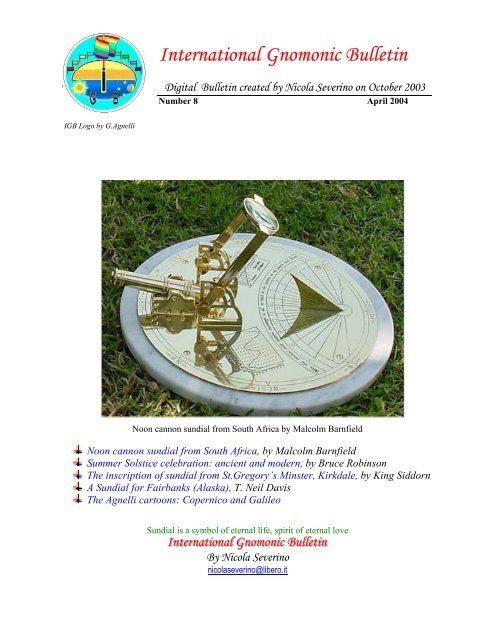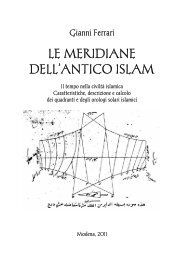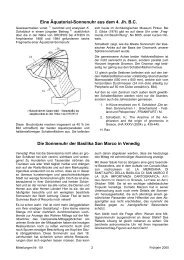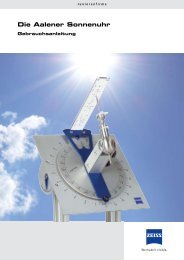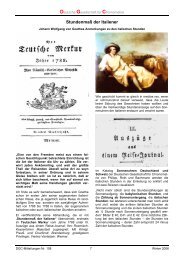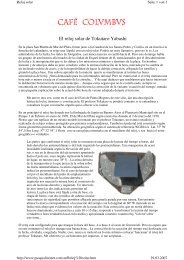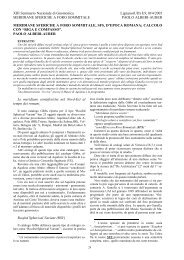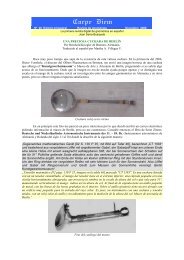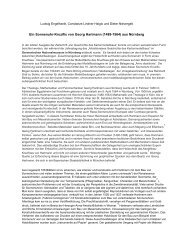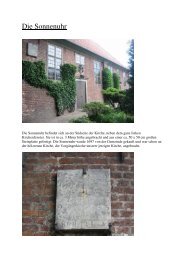International Gnomonic Bulletin - Gnomonica by Nicola Severino
International Gnomonic Bulletin - Gnomonica by Nicola Severino
International Gnomonic Bulletin - Gnomonica by Nicola Severino
You also want an ePaper? Increase the reach of your titles
YUMPU automatically turns print PDFs into web optimized ePapers that Google loves.
<strong>International</strong> <strong>Gnomonic</strong> <strong>Bulletin</strong><br />
Digital <strong>Bulletin</strong> created <strong>by</strong> <strong>Nicola</strong> <strong>Severino</strong> on October 2003<br />
Number 8 April 2004<br />
IGB Logo <strong>by</strong> G.Agnelli<br />
Noon cannon sundial from South Africa <strong>by</strong> Malcolm Barnfield<br />
Noon cannon sundial from South Africa, <strong>by</strong> Malcolm Barnfield<br />
Summer Solstice celebration: ancient and modern, <strong>by</strong> Bruce Robinson<br />
The inscription of sundial from St.Gregory’s Minster, Kirkdale, <strong>by</strong> King Siddorn<br />
A Sundial for Fairbanks (Alaska), T. Neil Davis<br />
The Agnelli cartoons: Copernico and Galileo<br />
Sundial is a symbol of eternal life, spirit of eternal love<br />
Intteerrnattiionall Gnomoniicc Bulllleettiin<br />
By <strong>Nicola</strong> <strong>Severino</strong><br />
nicolaseverino@libero.it
Noon Cannon Sundial from South Africa<br />
By Malcolm Barfield<br />
Wanting to show their love for Joann, many of her patients and friends gave money to a<br />
memorial fund to create something that would continue Joann's belief and work in the<br />
importance of healing, education and the beauty of nature.<br />
Joann was a great humanitarian, teacher and healer. As long as I am alive, her dream of<br />
touching others will not die.<br />
History<br />
After many nights of searching on the Internet, I found a sundial that was "the one". The only<br />
problem was that it was in a planetarium in Germany and the language was all German. I<br />
took a chance and sent an email. The Director replied and we corresponded about the<br />
classroom. He said, "You will not be able to get this exact sundial because it is one of a kind<br />
and a replica would be very expensive."<br />
Once I found the sundial I emailed at least 50 sundial makers around the world, and the only<br />
reply that was right finally came from South Africa. When I read his reply, I knew he was the<br />
ONE. Many told me it would be too expensive. Many said they couldn't make it. Many said it<br />
was not a good thing to have around children for vandalism purposes. Malcolm Barfield from<br />
South Africa said:<br />
Dear Janie, Thank you for the enquiry. I have seen the acoustical sundial pictured in the<br />
German website before. When orientated correctly the canon fires a shot at true local solar<br />
midday if it has been loaded and the sun is shining. I can do it. I will need the exact global<br />
position (degrees, minutes & seconds) in which the dial is to remain, a rough sketch with<br />
approximate dimensions of the base plate and the material you intend to use. The rest I will<br />
calculate. I will also need to know what wording you require on the base and in what language.<br />
I recommend brass for the dial as this is weather-proof and once the green patina has formed<br />
the dial will last forever. All dials I make come with etched plaques of the Equation of Time and<br />
Moondial. These plates are 68 x 115mm, so please allow space for them dial on the base of<br />
your choice. Your dial will also tell the time <strong>by</strong> moonlight and will be longitudinally corrected,<br />
so to obtain the legal hour all you have to do is apply the Equation for that day. The dial is also<br />
‘split’ <strong>by</strong> the thickness of the gnomon. This removes the inaccuracy caused <strong>by</strong> that very<br />
thickness before and after readings at midday.<br />
Your classroom is a marvelous idea and a worthwhile undertaking. Proof that good can come<br />
from adversity. You will be the stronger for it in the end. I often think of the war memorials I<br />
have seen all over the world. They bear the words 'Lest we forget'. We can't and don't and we<br />
go on firm in the knowledge that those who fell did so for a purpose. The Bible says that God<br />
moves in mysterious ways. Trust in yourself and your faith. There was a famous doctor who<br />
wrote 'Trust yourself, you know more than you think you know.' Think about it, you do and so<br />
you will be alright.<br />
The next week he emailed:<br />
Everything is now fully in place to proceed. My price is within the money you have in the<br />
memorial fund. This includes first class airmail postage, packing and insurance. The tracking<br />
number of the parcel will be emailed to you. The parcel will contain the sundial complete with<br />
marble base, magnifying glass on a bracket, cannon, ram rod, safety bolt, set up instructions,<br />
all fixing fasteners, a daily Equation of Time for the whole year, a schools sundial kit, the<br />
required Customs form PP4, an invoice and lecture notes.
Janie, Thanks for the coordinates. Henry the Navigator is proud of you! I have calculated the<br />
longitude correction as -11 mins 27 secs and this will be corrected on the dial itself so all you<br />
have to do to get the legal time is apply the Equation of Time. I have spoken to Henk and he<br />
guarantees me a 4 day turnaround for the engraving, so all in all we are well on track.<br />
The author web site is: www.icon.co.za/~sundials<br />
Thanks to Malcolm Branfield<br />
The Cannoneers
SUMMER SOLSTICE CELEBRATIONS:ANCIENT AND MODERN<br />
Bruce Robinson<br />
The Summer Solstice is also known as: Alban Heflin, Alben Heruin, All-couples day,<br />
Feast of Epona, Feast of St. John the Baptist, Feill-Sheathain, Gathering Day,<br />
Johannistag, Litha, Midsummer, Sonnwend, Thing-Tide, Vestalia, etc.<br />
Overview<br />
People around the world have observed spiritual and religious seasonal days of<br />
celebration during the month of June. Most have been religious holy days which are<br />
linked in some way to the summer solstice. On this day, typically JUN-21, the daytime<br />
hours are at a maximum in the Northern hemisphere, and night time is at a minimum. It<br />
is officially the first day of summer. It is also referred to as Midsummer because it is<br />
roughly the middle of the growing season throughout much of Europe.<br />
"Solstice" is derived from two Latin words: "sol" meaning sun, and "sistere," to cause to<br />
stand still. This is because, as the summer solstice approaches, the noonday sun rises<br />
higher and higher in the sky on each successive day. On the day of the solstice, it rises<br />
an imperceptible amount, compared to the day before. In this sense, it "stands still."<br />
(In the southern hemisphere, the summer solstice is celebrated in December, also when<br />
the night time is at a minimum and the daytime is at a maximum. We will assume that<br />
the reader lives in the Northern hemisphere for the rest of this essay.)<br />
How people view solstice celebrations:<br />
People view other religions in various ways, and thus treat the celebrations of other<br />
faiths differently:<br />
For some people, religious diversity is a positive factor. They enjoy the variety of June<br />
celebrations, because it is evidence of wide range of of beliefs within our common<br />
humanity. They respect both their own religious traditions and those of other faiths for<br />
their ability to inspire people to lead more ethical lives.<br />
Others reject the importance of all celebrations other than the holy day(s) recognized<br />
<strong>by</strong> their own religion. Some even reject their religion's traditional holy days if they are<br />
convinced that they have Pagan origins. This is a common occurrence with Easter and<br />
Christmas.<br />
Some view other religions as being inspired, controlled, or even led <strong>by</strong> Satan. Thus the<br />
solstice celebrations of other religions are rejected because they are viewed as Satanic<br />
in origin.
Why does the summer solstice happen?<br />
The seasons of the year are caused <strong>by</strong> the 23.5º tilt of the earth's axis. Because the<br />
earth is rotating like a top or gyroscope, the North Pole points in a fixed direction<br />
continuously -- towards a point in space near the North Star. But the earth is also<br />
revolving around the sun. During half of the year, the southern hemisphere is more<br />
exposed to the sun than is the northern hemisphere. During the rest of the year, the<br />
reverse is true. At noontime in the Northern Hemisphere the sun appears high in the sky<br />
during summertime, and low during winter. The time of the year when the sun reaches<br />
its maximum elevation occurs on the summer solstice -- the day with the greatest<br />
number of daylight hours. It typically occurs on, or within a day or two of, JUN-21 -- the<br />
first day of summer. The lowest elevation occurs about DEC-21 and is the winter solstice<br />
-- the first day of winter, when the night time hours reach their maximum.<br />
Significance of the summer solstice:<br />
In pre-historic times, summer was a joyous time of the year for those Aboriginal people<br />
who lived in the northern latitudes. The snow had disappeared; the ground had thawed<br />
out; warm temperatures had returned; flowers were blooming; leaves had returned to<br />
the deciduous trees. Some herbs could be harvested, for medicinal and other uses. Food<br />
was easier to find. The crops had already been planted and would be harvested in the<br />
months to come. Although many months of warm/hot weather remained before the fall,<br />
they noticed that the days were beginning to shorten, so that the return of the cold<br />
season was inevitable.<br />
The first (or only) full moon in June is called the Honey Moon. Tradition holds that this is<br />
the best time to harvest honey from the hives.<br />
This time of year, between the planting and harvesting of the crops, was the traditional<br />
month for weddings. This is because many ancient peoples believed that the "grand<br />
[sexual] union" of the Goddess and God occurred in early May at Beltaine. Since it was<br />
unlucky to compete with the deities, many couples delayed their weddings until June.<br />
June remains a favorite month for marriage today. In some traditions, "newly wed<br />
couples were fed dishes and beverages that featured honey for the first month of their<br />
married life to encourage love and fertility. The surviving vestige of this tradition lives<br />
on in the name given to the holiday immediately after the ceremony: The Honeymoon."<br />
14<br />
Midsummer celebrations in ancient and modern times:<br />
Most societies in the northern hemisphere, ancient and modern, have celebrated a<br />
festival on or close to Midsummer:<br />
Ancient Celts: Druids, the priestly/professional/diplomatic corps in Celtic countries,<br />
celebrated Alban Heruin ("Light of the Shore"). It was midway between the spring<br />
Equinox (Alban Eiler; "Light of the Earth") and the fall Equinox (Alban Elfed; "Light of<br />
the Water"). "This midsummer festival celebrates the apex of Light, sometimes<br />
symbolized in the crowning of the Oak King, God of the waxing year. At his crowning,
the Oak King falls to his darker aspect, the Holly King, God of the waning year..." 13 The<br />
days following Alban Heruin form the waning part of the year because the days become<br />
shorter.<br />
Ancient China: Their summer solstice ceremony celebrated the earth, the feminine,<br />
and the yin forces. It complemented the winter solstice which celebrated the heavens,<br />
masculinity and yang forces.<br />
Ancient Gaul: The Midsummer celebration was called Feast of Epona, named after a<br />
mare goddess who personified fertility, sovereignty and agriculture. She was portrayed<br />
as a woman riding a mare.<br />
Ancient Germanic, Slav and Celtic tribes in Europe: Ancient Pagans celebrated<br />
Midsummer with bonfires. "It was the night of fire festivals and of love magic, of love<br />
oracles and divination. It had to do with lovers and predictions, when pairs of lovers<br />
would jump through the luck-bringing flames..." It was believed that the crops would<br />
grow as high as the couples were able to jump. Through the fire's power, "...maidens<br />
would find out about their future husband, and spirits and demons were banished."<br />
Another function of bonfires was to generate sympathetic magic: giving a boost to the<br />
sun's energy so that it would remain potent throughout the rest of the growing season<br />
and guarantee a plentiful harvest. 6<br />
Ancient Rome: The festival of Vestalia lasted from JUN-7 to JUN-15. It was held in<br />
honor of the Roman Goddess of the hearth, Vesta. Married women were able to enter<br />
the shrine of Vesta during the festival. At other times of the year, only the vestal virgins<br />
were permitted inside.<br />
Ancient Sweden: A Midsummer tree was set up and decorated in each town. The<br />
villagers danced around it. Women and girls would customarily bathe in the local river.<br />
This was a magical ritual, intended to bring rain for the crops.<br />
Christian countries: After the conversion of Europe to Christianity, the feast day of<br />
St. John the Baptist was set as JUN-24. It "is one of the oldest feasts, if not the oldest<br />
feast, introduced into both the Greek and Latin liturgies to honour a saint." 16<br />
Curiously, the feast is held on the alleged date of his birth. Other Christian saints' days<br />
are observed on the anniversary of their death. The Catholic Encyclopedia explains that<br />
St. John was "filled with the Holy Ghost even from his mother's womb...[thus his]<br />
birth...should be signalized as a day of triumph." 16 His feast day is offset a few days<br />
after the summer solstice, just as Christmas is fixed a few days after the winter solstice.<br />
1 "Just as John was the forerunner to Jesus, midsummer forecasts the eventual arrival<br />
of" the winter solstice circa DEC-21.<br />
Essenes: This was a Jewish religious group active in Palestine during the 1st century<br />
CE. It was one of about 24 Jewish groups in the country -- the only one that used a solar<br />
calendar. Other Jewish groups at the time included the Sadducees, Pharisees, Zealots,<br />
followers of John, and followers of Yeshua (Jesus). Archeologists have found that the<br />
largest room of the ruins at Qumran (location of the Dead Sea Scrolls) appears to be a<br />
sun temple. The room had been considered a dining room <strong>by</strong> earlier investigators, in<br />
spite of the presence of two altars at its eastern end. At the time of the summer<br />
solstice, the rays of the setting sun shine at 286 degrees along the building's longitudinal<br />
axis, and illuminate the eastern wall. The room is oriented at exactly the same angle as<br />
the Egyptian shrines dedicated to the sun. Two ancient authorities -- the historian<br />
Josephus and the philosopher Filon of Alexandria -- had written that the Essenes were<br />
sun worshipers. Until now, their opinion had been rejected <strong>by</strong> modern historians. 19<br />
Native Americans:<br />
The Natchez tribe in the southern U.S. "worshiped the sun and believed that their<br />
ruler was descended from him. Every summer they held a first fruits ceremony." Nobody<br />
was allowed to harvest the corn until after the feast. 2
Males in the Hopi tribe dressed up as Kachinas - the dancing spirits of rain and fertility<br />
who were messengers between humanity and the Gods. At Midsummer, the Kachinas<br />
were believed to leave the villages to spend the next six months in the mountains,<br />
where they were believed to visit the dead underground and hold ceremonies on their<br />
behalf. 2<br />
Native Americans have created countless stone structures linked to equinoxes and<br />
solstices. Many are still standing. One was called Calendar One <strong>by</strong> its modern-day<br />
finder. It is in a natural amphitheatre of about 20 acres in size in Vermont. From a stone<br />
enclosure in the center of the bowl, one can see a number of vertical rocks and other<br />
markers around the edge of the bowl "At the summer solstice, the sun rose at the<br />
southern peak of the east ridge and set at a notch at the southern end of the west<br />
ridge." The winter solstice and the equinoxes were similarly marked. 5<br />
The Bighorn Medicine Wheel west of Sheridan, WY is perhaps the most famous of the<br />
40 or more similar "wheels" on the high plains area of the Rocky Mountains. Mostly are<br />
located in Canada. At Bighorn, the center of a small cairn, that is external to the main<br />
wheel, lines up with the center of the wheel and the sun rising at the summer equinox.<br />
Another similar sighting cairn provides a sighting for three dawn-rising stars: Aldebaran,<br />
Rigel and Sirius. A third cairn lines up with fourth star: Fomalhaut. The term "medicine<br />
wheel" was coined <strong>by</strong> Europeans; it was a term used to describe anything native that<br />
white people didn't understand. 17<br />
Neopaganism: This is a group of religions which are attempted re-constructions of<br />
ancient Pagan religions. Of these, Wicca is the most common; it is loosely based partly<br />
on ancient Celtic beliefs and practices. Wiccans recognize eight seasonal days of<br />
celebration. Four are minor sabbats and occur at the two solstices and the two<br />
equinoxes. The other are major sabbats which happen approximately halfway between<br />
an equinox and solstice. The summer solstice sabbat is often called Midsummer or Litha.<br />
Wiccans may celebrate the sabbat on the evening before, at sunrise on the morning of<br />
the solstice, or at the exact time of the astronomical event.<br />
"Midsummer is the time when the sun reaches the peak of its power, the earth is green<br />
and holds the promise of a bountiful harvest. The Mother Goddess is viewed as heavily<br />
pregnant, and the God is at the apex of his manhood and is honored in his guise as the<br />
supreme sun." 12<br />
It is a time for divination and healing rituals. Divining rods and wands are traditionally<br />
cut at this time.<br />
Prehistoric Europe: Many remains of ancient stone structures can be found<br />
throughout Europe. Some date back many millennia BCE. Many appear to have<br />
religious/astronomical purposes; others are burial tombs. These structures were built<br />
before writing was developed. One can only speculate on the significance of the summer<br />
solstice to the builders. Perhaps the most famous of these structures is Stonehenge, a<br />
megalith monument on Salisbury Plain in Wiltshire. It was built in three stages, between<br />
circa 3000 and 1500 BCE. "The circular bank and ditch, double circle of 'bluestones'<br />
(spotted dolerite), and circle of sarsen stones (some with white lintels), are concentric,<br />
and the main axis is aligned on the midsummer sunrise--an orientation that was<br />
probably for ritual rather than scientific purposes. 4 Four "station stones" within the<br />
monument form a rectangle whose shorter side also points in the direction of the<br />
midsummer sunrise. 15
The dates and times of the summer solstice:<br />
The exact date varies from year to year and may occur between the 20th and 23rd of<br />
June.<br />
Year Summer solstice (UT)<br />
1999 JUN-21 @ 19:49<br />
2000 JUN-21 @ 01:47<br />
2001 JUN-21 @ 07:37<br />
2002 JUN-21 @ 13:24<br />
2003 JUN-21 @ 19:10<br />
2004 JUN-21 @ 00:56<br />
The above dates and times were provided the astronomical calculations on The Dome of<br />
the Sky web site. 9 Times are in UT (Universal Time). This used to be called Greenwich<br />
Mean Time or GMT. In North America, you can find your local time <strong>by</strong> subtracting:<br />
2 hours 30 minutes for Newfoundland daylight savings time<br />
3 hours for ADT<br />
4 hours for EDT<br />
5 hours for CDT<br />
6 hours for MDT<br />
7 hours for PDT<br />
8 hours in AKDT (Alaska)<br />
9 hours in ADT (Aleutian Islands)<br />
10 hours in HST (Hawaii) 10<br />
The ancients did not have access to modern mathematical algorithms to calculate the<br />
date and time of the solstice. To the unaided eye, the sun would seem to set/rise at the<br />
same location on the horizon for about five days before and after the actual solstice.<br />
Ancient people would record the days when the sun rise or set was noticeably different<br />
from the extreme position, and interpolate the probable day of the solstice. They then<br />
used a variety of techniques to display future solstices:<br />
A carved or painted symbol, or some other marker, would be located at the end of a<br />
long passage that was exposed to sunrise or sunset on the solstice. It would be<br />
illuminated <strong>by</strong> the rising or setting of the sun on the day of the solstice. Alternately, a<br />
hole in the roof of a structure would allow the noonday sun to shine onto a marker set<br />
into the floor.<br />
In temperate zones, the shadow of an upright pillar would be observed at noontime at<br />
the summer solstice. The shadow would be shortest on that day.<br />
The point on the horizon where the sun set and rose would be observed from a fixed<br />
location. A remote marker would indicate where the sun rose or set on the solstice. 3
References:<br />
1. "Summer solstice - Johannisnacht - Midsummer night," at:<br />
http://www.serve.com/shea/germusa/midsumm.htm<br />
2. Robin DuMolin, "Summer Solstice," at:<br />
http://www.celestia.com/alpha/SRP/JJ95/Html/SummerSolstice.html<br />
3. Robin DuMolin, "Summer Solstice," at:<br />
http://www.celestia.com/alpha/SRP/MJ96/SummerSolstice.html<br />
4. Christiaan Stoudt, "Stonehenge: Gateway to the realms," at:<br />
http://www.christiaan.com/stonehenge/stonemain.html<br />
5. Janet & Stewart Farrar, "Eight Sabbats for Witches," Phoenix Publishing, (1981),<br />
P. 143 to 144.<br />
6. "Summer Solstice," at: http://users.erols.com/tlatham/solst/summer.htm<br />
7. J.W. Mavor & B.E. Dix, "Manitou: The sacred landscape of New England's Native<br />
Civilization." Inner Traditions (1989).<br />
8. Selena Fox, "Summer solstice celebrations for families and households,"<br />
http://www.circlesanctuary.org/pholidays/SolsticePlanningGuide.html<br />
9. "Find the equinoxes and solstices for a particular year," at<br />
http://einstein.stcloudstate.edu/Dome/equiSol.html<br />
10. "World Time Zone: Accurate local times," at:<br />
http://www.isbister.com/worldtime/<br />
11. "Litha," a list of links to web sites about Litha, is at:<br />
http://paganwiccan.about.com/religion/paganwiccan/msublitha.htm?once=true&<br />
12. "Litha," a description of the festival from a Neopagan perspective, is at:<br />
http://home.att.net/~haleth/litha.html<br />
13. "Litha: Summer Solstice," at:<br />
http://www.<strong>by</strong>zant.com/scriptorium/festivals/litha.html<br />
14. "Morgana, "Ritual feasts - handfasting," at:<br />
http://www.newavalon.com/issue10/kitchen.html<br />
15. G.S. Hawkins, "Stonehenge decoded," Doubleday (1965), Pages 46 & 47.<br />
16. C.L. Souvay, "St. John the Baptist," The Catholic Encyclopedia, at:<br />
http://www.newadvent.org/cathen/08486b.htm<br />
17. Paula Giese, "Medicine wheel: Sun & Stars," at:<br />
http://indy4.fdl.cc.mn.us/~isk/stars/starkno5.html<br />
18. The Center for Archaeoastronomy publishes a four page quarterly newsletter,<br />
appropriately published on the equinoxes and solstices. See:<br />
http://www.wam.umd.edu/~tlaloc/archastro/ae.html<br />
19. M Lnnqvist & K Lnnqvist, "Archeology of the Hidden Qumran: The new paradigm,"<br />
(2002) a book advertised at:<br />
http://www.akateeminen.com/uutuudet/historia.htm<br />
Thanks to Bruce Robinson for his contribute to IGB and the site: www.religioustolerance.org
Language<br />
The sundial from St. Gregory's Minster, Kirkdale in North Yorkshire. The inscription ostentatiously recalls the<br />
good works of one Viking, written in Latin, on an Anglo-Saxon church. It translates: 'Orm, Gamal's son,<br />
bought St. Gregory's Mynster when it was all broken down and fallen and he let it be made anew from the<br />
ground to Christ and to St. Gregory in the days of Edward the King and Tostig the Earl. This is the day's sun<br />
marking at each hour. And Haward me wrought and Brand Priest.' From this we can surmise that the<br />
previous structure had probably fallen prey to the Danes, and the mention of Tostig dates it to 1066 or a little<br />
earlier. It is thought that it is still in it's initial setting. Haward probably carved it with Brand the Priest setting<br />
the text.<br />
photo reproduced with the kind permission of Regia Anglorum <br />
Thanks to Kim Siddorn of Regia Anglorum.<br />
Letters<br />
Hello <strong>Nicola</strong>s,<br />
Thanks for making the IGBs available directly from your web site. The Yahoo system was not very<br />
easy to use. I very much enjoy reading the bulletins. I was interested in the quadrant and ring at St<br />
John's College shown in the latest <strong>International</strong> <strong>Gnomonic</strong> <strong>Bulletin</strong> 07. The equatorial ring has a<br />
long history. It is this type of ring that the Greek astronomers used to precisely determine the time<br />
of the equinox. From these equinox timings Hipparchus about 130 BC was able to determine the<br />
precession of the earth's axis of rotation. I would love to have access to such a ring to see the<br />
equinox shadow as the declination of the sun changes rapidly ~24'/day.<br />
There were a few minor errors in the article. The link no longer works.<br />
Try<br />
http://www.stjohnscollege.edu/asp/main.aspx?page=6591&parent=1106#quad .<br />
This will bring up the new page showing the ring but the picture is no longer in colour. The IGB<br />
article places the quadrant and ring in Santa Fe but they are at the St. John's campus in Annapolis.<br />
Regards,<br />
Roger Bailey<br />
N 48.6 W 123.4
A Sundial for Fairbanks 1<br />
T. Neil Davis<br />
This column is provided as a public service <strong>by</strong> the Geophysical Institute, University of Alaska<br />
Fairbanks, in cooperation with the UAF research community. T. Neil Davis is a seismologist<br />
at the institute.<br />
Sundials were on their way out a thousand years ago when fledgling inventions led to the<br />
development of modern clocks. In those early times the hour had no fixed length; it<br />
depended upon season and latitude.<br />
Simplest of all sundials is one with a vertical pointer (a gnomon) which casts its shadow<br />
on a flat surface marked to show the passage of the hours. We show here such a sundial<br />
designed specifically for Fairbanks. In one sense it is a rather fancy sundial because it<br />
tells both the hour of the day and the day of the year. This ability comes from the use of<br />
the University's high-speed computer, which gives us a leg up on the old-time sundial<br />
designers. The design is based upon calculations <strong>by</strong> Professor Hans Nielsen showing the<br />
1 This article was published on Alaska Science Forum, November, 15, 1977. Thanks to T. Neil Devis, the column’s<br />
authors and the Geophysical Institute <strong>International</strong> Arctic Research Center University of Alaska Fairbanks for the kind<br />
permission to use it here.
length of a vertical stick's shadow each hour of the day and the direction to the shadow<br />
tip.<br />
Dashed lines show the paths of the end of the pointer's shadow across the sundial on the<br />
days indicated. We drew in only the twenty-first day of each month to illustrate the<br />
extreme positions occurring on the solstices (June 21 and December 21) and at equinox<br />
(March 21 and September 21).<br />
Moving along the line marked June 21, one sees that the Fairbanks sundial works from<br />
before 3 a.m. until after 9 p.m. But on the shortest day of the year, December 21, it only<br />
works from about ll a.m. until l p.m., the time when the sun is above the horizon.<br />
Notice that the sundial is 25 pointer lengths in radius. On December 21 the shadow<br />
doesn't even fall on the sundial; we indicate that <strong>by</strong> using a dotted line and the special<br />
distance scale marked <strong>by</strong> asterisks.<br />
The radial hour lines of the sundial are curved to account for the changes in the sun's<br />
apparent motion across the sky with season. If the lines were not curved, the sundial<br />
"clock" would run faster than a normal clock at some times of the year and at other<br />
times, slower.<br />
This sundial illustrates that Alaska truly is the land of long shadows, with remarkable<br />
variations through the course of the year. One curiosity--notice that the shadow of the tip<br />
of an object marches across the ground in a perfectly straight line on two days of the<br />
year, the equinox days.<br />
Though called a sundial for Fairbanks, this one will work reasonably well any location<br />
of similar latitude, locations such as Dawson, Eagle, Tanana, Nulato and Nome.
Giacomo Agnelli Cartoons<br />
Translation:<br />
1 - COPERNICUS THINKS IT AND GALILEO SEES IT: IT IS THE EARTH THAT TURNS<br />
AROUND THE SUN<br />
2 - (but the "Holy Office" does not want this)<br />
3 – This is how it is! The sun is firm and it is the earth that turns around<br />
it...<br />
4 – it really is this way... and I see it!<br />
5 -... no! Nein... VERRBOTEN, Niet...<br />
6 - no! it is not so...<br />
7 - and the Earth - in substance - laughs and goes on doing as it wants.


